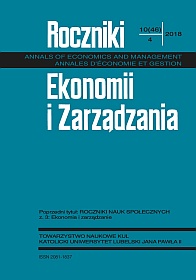The Impact of the Foreign Exchange Market on the Interbank Interest Rates and the Credit Activity of Hungarian Households
Abstract
The study attempts to assess the impact of developments in the forint exchange rate against euro on the level of interest rates on the Hungarian interbank market and the observed credit activity of the household sector. The analysis showed the flow of Granger causality sense within the mechanism of monetary transmission from the currency market to the credit activity of Hungarian households, especially in contract periods of more than one year and five years. At the same time, the transmission of information between the forint exchange rate (EUR/HUF) and the Hungarian interbank market showed the bidirectional impact of impulses.
References
Bask M., de Luna X., EMU and the Stability and Volatility of Foreign Exchange: Some Empirical Evidence, „Chaos, Solitions and Fractals” 25(2005), s. 737-750.
Baum C., Caglayan M., Barkoulas J., Exchange Rate Uncertainty and Firm Profitability, „Journal of Macroeconomics” 23(2001), nr 4, s. 565-576.
Bednarz J., Analiza kursów walut państw grupy wyszehradzkiej, „Prace Naukowe Uniwersytetu Ekonomicznego we Wrocławiu” 2011, nr 174, s. 163-173.
Bednarz J., Gędek S., Współzależności kursów euro i funta brytyjskiego, „Metody Ilościowe w Badaniach Ekonomicznych” 8(2007), s. 25-34.
Belke A., Setzer R., Cost of Exchange Rate Volatility for Labour Markets: Empirical Evidence from the CEE Economies, „The Social and Economic Review” 34(2003), nr 3, s. 267-292.
Benita G., Lauterbach B., Policy Factors and Exchange Rate Volatility, Panel Data versus a Specific Country Analysis, „International Research Journal of Finance and Economics” 7(2007), s. 7-22.
Bolibok P., The Macroeconomic Drivers of Household Debt-to-Income Ratio: An Evidence from the OECD Countries, „Copernican Journal of Finance & Accounting” 7(2018), nr 2, s. 29-41.
Borio C., The Financial Cycle and Macroeconomics: What Have we Learnt?, „Journal of Banking & Finance” 45(2014), s. 182-198.
Bouchouicha R., Ftiti Z., Real Estate Markets and the Macroeconomy: A Dynamic Coherence Framework, „Economic Modelling” 29(2012), s. 1820-1829.
Byrne J., Davis E., The Impact of Short and Long Run Exchange Rate Uncertainty on Investment: A Panel Study of Industrial Countries, „Oxford Bulletin of Economics and Statistics” 67(2005), nr 3, s. 307-329.
Cerutti E., Claessens S., Laeven L., The Use and Effectiveness of Macroprudential Policies: New Evidence, „Journal of Financial Stability” 25(2017), s. 203-224.
Case K., Real Estate and the Macroeconomy, „Brooking Papers on Economic Activity” 2000, nr 2, s. 119-162.
Charemza W., Deadman D., Nowa ekonometria, PWE, Warszawa 1997.
Dedu V., Stoica T., The Monetary Policy and the Real Estate Market, „Theoretical and Applied Economics” 12(2011), nr 565, s. 5-14.
Dreger C., Stadtmann G., What Drives Heterogenity in Foreign Exchange Rate Expectations: Insightsfrom a New Survey, „International Journal of Finance and Economics” 13(2008), s. 360-367.
Engle R., Granger C., Co-Integration and Error Correction, „Econometrica” 55(1987), s. 251-276.
Galí J., Monacelli T., Monetary Policy and Exchange Rate Volatility in a Small open Economy, „Review of Economic Studies” 72(2005), s. 707-734.
Giuliodori M., The Role of House Prices in the Monetary Transmission Mechanism across European Countries, „Scottish Journal of Political Economy” 52(2005), nr 4, s. 519-543.
Granger C., Investigation Causal Relations by Econometric Models and Cross-Spectral Methods, „Econometrica” 37(1969), nr 3, s. 424-438.
Johansen S., Modelling of Cointegration in the Vector Autoregressive Model, „Economic Modelling” 17(2000), nr 3, s. 359-373.
Johansen S., Statistical Analysis of Cointegration Vectors, „Journal of Economic Dynamics and Control” 12(1988), s. 231-254.
Johansen S., Juselius K., Maximum Likelihood Estimation and Inference on Cointegration with Applications to the Demand for Money, „Oxford Bulletin of Economics and Statistics” 52(1990), s. 169-210.
Karras G., Lee J., Stokes H., Sources of Exchange-Rate Volatility. Impulses or Propagation?, „International Review of Economics and Finance” 14(2005), s. 213-226.
Kiss G., Vadas G., The Role of Housing Market in Monetary Transmission – Evidence from Hungary, „European Journal of Housing Policy” 7(2007), nr 3, s. 299-317.
Kusideł E., Modele wektorowo-autoregresyjne VAR. Metodologia i zastosowania, Absolwent, Łódź 2000.
Ljung G., Box G., On a Measure of Lack of Fit in Time Series Models, „Biometrika” 65(1978), nr 2, s. 297-303.
MacDonald R., Exchange Rate Behaviour: Are Fundametals Important?, „The Economic Journal” 109(1999), s. 673-691.
Maddala G., Ekonometria, Wydawnictwo Naukowe PWN, Warszawa 2006.
Majsterek M., Zastosowanie procedury Johansena do analizy sprzężenia inflacyjnego w gospodarce polskiej, „Przegląd Statystyczny” 45(1998), s. 113-130.
Mishkin F., Symposium on the Monetary Transmission Mechanism, „Journal of Economic Perspectives” 9(1995), nr 2, s. 3-10.
Mussa M., The Euro versus the Dollar: Not a Zero Sum Game, „Journal of Policy Modeling” 24(2002), s. 361-372.
Osińska M., Ekonometria finansowa, PWE, Warszawa 2006.
Ozmer-Imer I., Ozkan I., An Empirical Analysis of Currency Volatilities During the Recent Global Financial Crisis, „Economic Modelling” 43(2014), s. 394-406.
Roulac S., Real Estate Value Chain Connections: Tangible and Transparent, „Journal of Real Estate Research” 17(1999), s. 387-404.
Tarashev N., Speculative Attacks and the Information Role of Interest Rate, „Journal of the European Economic Association” 5(2007), s. 1-36.
Tatarczak E., Badanie stacjonarności oraz analiza kointegracji kursów walutowych, „Roczniki Nauk Rolniczych” 94(2007), s. 149-156.
Welfe A., Ekonometria. Metody i ich zastosowanie, PWE, Warszawa 2009.
Witkowska D., Kointegracja kursów walutowych Polski, Węgier i Czech, „Metody Ilościowe w Badaniach Ekonomicznych” 13(2011), s. 399-408.
Copyright (c) 2018 Roczniki Ekonomii i Zarządzania

This work is licensed under a Creative Commons Attribution-NonCommercial-NoDerivatives 4.0 International License.


